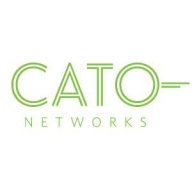

![Citrix SD-WAN [EOL] Logo](https://images.peerspot.com/image/upload/c_scale,dpr_3.0,f_auto,q_100,w_64/r353lx2ff1iz086wtljecg7wmrvo.jpg)
Citrix SD-WAN and Cato SASE Cloud Platform are contenders in the network and security solutions space. Cato SASE Cloud Platform seems to have the upper hand with its strong emphasis on integrated security features and simplicity in deployment.
Features: Citrix SD-WAN excels in robust connectivity and application reliability, offering load balancing and backup capabilities that enhance performance. It is customizable, flexible, and user-friendly in management. Cato SASE Cloud Platform is notable for integrated security features, centralized management, and effective traffic optimization. The self-healing model and CASB make deployment easier for complex branched networks.
Room for Improvement: Citrix SD-WAN could enhance reporting, pricing, and troubleshooting, with calls for improved licensing options and robust security features. Cato SASE Cloud Platform users seek enhanced web application firewall features, broader integration capabilities, and UI and language improvements, noting cost as an ongoing discussion point despite the feature set.
Ease of Deployment and Customer Service: Citrix SD-WAN offers on-premises deployment, praised for technical support but criticized for inconsistent service quality and high learning curves. Cato SASE Cloud Platform has diverse deployment options across cloud environments, with responsive support, though improvements are desired in first-line support efficiency.
Pricing and ROI: Citrix SD-WAN is seen as expensive with varied pricing structures but justified by performance and cost-management options like perpetual licensing, promising good ROI, especially in MPLS migration cost savings. Cato SASE Cloud Platform is competitively priced, providing cost savings in Telco expenses and streamlined management, though pricing flexibility is a strength.



| Company Size | Count |
|---|---|
| Small Business | 350 |
| Midsize Enterprise | 130 |
| Large Enterprise | 187 |
| Company Size | Count |
|---|---|
| Small Business | 14 |
| Midsize Enterprise | 7 |
| Large Enterprise | 10 |
| Company Size | Count |
|---|---|
| Small Business | 7 |
| Midsize Enterprise | 5 |
| Large Enterprise | 10 |
Fortinet FortiGate excels in providing integrated VPN, firewalling, and Unified Threat Management (UTM) with centralized management and high availability. It supports remote access and comprehensive threat protection, making it a preferred choice for securing networks.
Fortinet FortiGate offers a robust security platform with features such as strong intrusion prevention, application control, and web filtering. Its integration with Active Directory and SD-WAN functionality provides scalable solutions for large networks. Users appreciate its ease of use through centralized management interfaces, ensuring robust security with flexible configurations. However, FortiGate could enhance its graphical interface and technical support responsiveness, address firmware bugs and costly licensing, improve logging, integrate better with third-party tools, and strengthen scalability and memory for log storage. Complexity in configuration and the need for intuitive features are noted challenges, and there's a demand for advanced security, zero-trust capabilities, and AI integration.
What are the key features of Fortinet FortiGate?Fortinet FortiGate is widely implemented across industries like education, finance, and government. Companies use it for firewall protection, VPN, and SD-WAN capabilities, ensuring secure perimeter and data center security. It facilitates remote access management and traffic routing optimization, offering reliable security and connectivity solutions.
Cato Networks is a leading SASE (Secure Access Service Edge) platform, combining SD-WAN and network security to obtain a cloud-native service. Cato Networks optimizes and secures application access for users and identities. The platform delivers a next-generation secure networking architecture that minimizes legacy IT infrastructures’ complexity, costs, and risks. The goal of Cato Suite is to connect any user to any application securely and optimally.
Cato Suite runs on a private global network of more than 65 PoPs (points of presence) connected via SLA-backed network providers. The service can connect branches, data centers, users, and clouds. Cato can be deployed in stages to augment legacy network services.
Cato Suite delivers end-to-end route optimization for WAN and cloud traffic. The architecture is self-healing, enabling a high service uptime.
Cato Features
Cato Cloud has a global backbone to deliver a reliable, global network. Here are some key SD-WAN features of Cato Cloud.
What challenges does Cato Network solve?
MPLS (multi-protocol label switching) networks are usually expensive and limited in their capacity. Cato simplifies migrating to a faster, higher-capacity internet and SASE cloud. Cato SD-WAN appliances enable customers to improve usable capacity and resiliency.
Customers who suffer from the challenge of high latency and network inconsistency can use Cato to deliver a consistent connection and user experience to access on-premises and cloud applications.
Cato’s complete network security stack connects all branch locations to the Cato cloud, therefore protecting all traffic, both internet-bound and WAN, with enterprise-grade, cloud-based security services. This capability avoids having to backhaul internet traffic to a data center or hub or having to implement stand-alone cloud security solutions.
Organizations using Cato notice an acceleration of cloud traffic. Cato achieves this by routing all traffic from the edges to the PoP closest to the data center. Because of the close distance between the two, the latency is near zero.
Reviews from Real Users
An IT manager/project coordinator at a healthcare company says that “[Cato is] a cloud-based solution that integrates well with everything. They are the classic SaaS solution.”
Yeong-Gi L., a network engineer at Snetsystems, notes that “The solution is very stable. The scalability is quite good. Technical support was always helpful and responsive. The integration capabilities are not a problem at all.”
"The most valuable feature is that it also works as a next-gen firewall because it has security features," says Lorenzo S., senior solutions consultant Lead at MDI.
Citrix SD-WAN [EOL] enhances connectivity and performance by optimizing bandwidth utilization, ensuring reliable communication across branch offices and headquarter data centers. It offers centralized management, efficient deployment options, and improved network reliability.
Citrix SD-WAN [EOL] is designed for businesses seeking enhanced connectivity solutions that boost application performance while reducing costs. With HDX WAN Optimization and reliable Active-Active connectivity, it assures improved bandwidth management. Tailored for both cloud and on-premise deployments, it supports fast communication and seamless integration, making it user-friendly even for those with limited technical expertise. Security features and zero-touch deployments further enhance its appeal. However, users highlight areas needing improvement, such as configuration intuitiveness, pricing alignment for specific markets, and stability. Enhanced reporting, networking features, and technical support are desired. Integration with Windows, security elements like firewalls, and licensing clarity require attention to meet user expectations.
What are the key features of Citrix SD-WAN [EOL]?Industries benefit from Citrix SD-WAN [EOL] by leveraging its features to ensure stable, redundant connectivity between branches and data centers. Organizations experiencing frequent line failures or high reliance on bandwidth-heavy applications find it particularly useful. It caters to sectors needing reliable data management and enhanced networking.
We monitor all WAN Optimization reviews to prevent fraudulent reviews and keep review quality high. We do not post reviews by company employees or direct competitors. We validate each review for authenticity via cross-reference with LinkedIn, and personal follow-up with the reviewer when necessary.